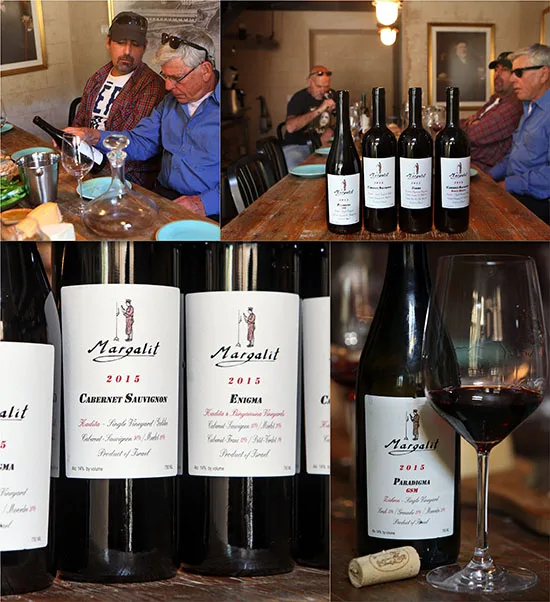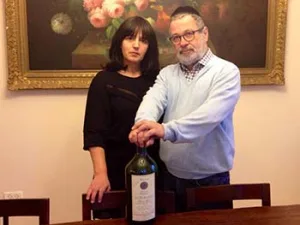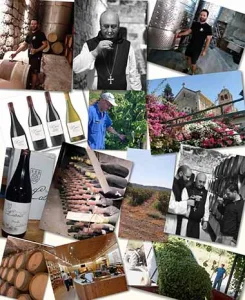Nearly one hundred and thirty years after Baron Edmond de Rothschild decided to planted vines in the valleys surrounding Zichron Ya’acov, the esteemed Margalit Winery has launched a new wine from their new vineyards planted there. It is a short in the arm for this most traditional of wine regions.
Rothschild loved the Mt. Carmel area. He fell in love with the sea, vineyards, hills and valleys, and decided to create an Israeli wine industry. He thought this was the Tuscany or Provence of Israel. He planted vineyards and built a very large commercial winery with deep underground cellars.
With time the vineyards of the Mount Carmel region became unfashionable as, in the search for quality, Israeli wine moved northwards and eastwards to the Galilee, Golan and Judean Hills respectively, in search of higher altitude.
Even wineries, with strong vineyard representation there, like Carmel and Tishbi, searched elsewhere for their better wines. The northern coastal region of vineyards was more an historical and folksy footnote, rather than the cutting edge of the new Israeli quality.
Dr. Yair Margalit has been a constant figure of the Israeli wine scene during the last 30 years and he remains one of the founding fathers of the Israel quality revolution. more » His interest in wine began from the time he was a visiting research professor at The University of California at Davis in the chemistry and enology departments.
In 1985, the veteran grower Yonatan Tishbi, decided to form his own winery and invited Yair Margalit to be his first winemaker. After a few years of home experimental winemaking, he founded Margalit Winery in 1989. In the first vintage they produced a mere 960 bottles. Margalit was the first serious boutique winery with quality and staying power.
The first wine was a Margalit Cabernet Sauvignon 1989, which was launched in 1991. It quickly gained a following amongst the wine cognoscenti as one of the best red wines in the country. The 1993 was one of the legendary vintages and it became Israel’s first cult wine.
From these little beginnings, Margalit wines grew in production, reputation – and price, but they never outgrew the ‘small boutique winery’ category. The wines became sought after and the rareness of the production created even more demand.
Yair Margalit would invite prospective customers to the premises at Kfar Bilu in Rehovot on two days a year. He offered them the opportunity to buy wines in advance and at slightly reduced prices. Today the wine lover has any number of wine tastings, launches or boutique wineries to visit on any given day of the year. In those days, the idea was innovative. It was a rare place for wine collectors to meet a winemaker, taste wine and buy wines not readily available elsewhere.
After Rehovot, the winery moved to a packing house just south of Hadera. It has now settled in Binyamina, near the station.
The wine that Margalit became most famous for, was his Cabernet Sauvignon and Cabernet based blend, but his strictly allocated Special Reserve, a Cabernet Sauvignon with up to 15% Petite Sirah, was also a unique and magnificent wine. Over the years he flirted with white varieties producing a Sauvignon Blanc and Chardonnay. He also produced a Carignan in 1999. It is a fact that the winery grew to specialize in the main Bordeaux varieties, Cabernet Sauvignon, Merlot and Cabernet Franc. However, credit where it is due; the rejuvenation of Petite Sirah and Carignan in Israel, a significant trend of the 2000’s, may be said to have started with Margalit. He also was the first to produce a varietal Cabernet Franc.
During all this time, Yair Margalit generously gave his time and expertise to advise and assist other new boutique wineries. In this way he helped fuel the boutique wine revolution. He continued to teach and lecture at Faculty of Food Technology in Haifa, and became the first professional manager & coordinator of the Cellar Master Course at Tel Hai College. He also found time to write books on winemaking. They are text books eagerly used by budding winemakers, students or especially interested connoisseurs.
Eventually, Yair’s son, Assaf, came into the business. He began by helping his father. After studies at the Hebrew University’s Faculty of Agriculture in Rehovot, he went to gain experience at Jekel Winery in California. They became a father and son partnership. When he became winemaker, with the ongoing advice of his father, Margalit wines became more elegant and old world in style and less concentrated. In other words they have changed as the Israeli palate has developed to ensure they are still leading the quality curve. However they have remained specialists in Bordeaux varieties, Cabernet Sauvignon, Cabernet Franc and Merlot.
Assaf is a laid back figure. Broad backed, hair swept back in a cuckoo, usually wearing a t shirt, he is quiet, chilled out and easy going. When winemaking or talking about his winery, he undergoes a metamorphosis. He becomes animated, passionate, hands on and the pride and perfectionism shine through. Only then do you receive an insight into why Margalit wines continue to maintain their position as one of Israel’s finest wineries. He is without doubt one of the leading winemaking talents in Israel today. It seems the apple has not fallen far from the tree.
Up to now, the wines came from two vineyards. One is at Kadita in the Upper Galilee, in the foothills of Mount Meron, from where the winery receives its Cabernet Sauvignon and Merlot. The other is in Binyamina, where their Cabernet Franc is grown.
So when the son and the father decided to plant Mediterranean varieties like Syrah, Grenache & Mourvedre, it was a surprise because the winery was so associated with Bordeaux varieties. Like many in Israel, they have decided that an eastern Mediterranean country should also grow Mediterranean varieties. However being Margalits, they were not satisfied with purchasing grapes. They wanted their own vineyards and one would have thought they would go north. However, after a seven year search they found what they were looking for in Zichron Ya’acov, just like Rothschild so long before. Their vineyard lies in the part of the Hanadiv Valley that rises towards Zichron. There they chose a plot with a light, chalky soil to plant their new Mediterranean varieties along with Chardonnay and Riesling.
Only now after a further four years of experimentation they launched their new GSM wine (a Mediterranean style wine made from Grenache, Syrah and Mourvèdre). The new wine which heralds the new direction is called Paradigma. Their Bordeaux blend is called Enigma. One symbolizes clarity, the other mystery. An interesting choice of names, which at least may encourage you to find your Roget’s Thesaurus!
Margalit Winery continues in a quiet unobtrusive way. All is very low key, laid back and the marketing is like the labels, on a principle of less is more. Let the wines speak for themselves. No frantic press releases, promotions, press events here. I recently tasted the 1996 Special Reserve. The nose was superb but the wine showed its age on the palate. I was then offered the sublime 1997, drinking superbly after 20 years. It was astonishingly good. Without doubt the two Israeli wineries best able to cope with long term cellaring are Yarden and Margalit. Remember that when you buy wine to lay down for your children!
In his own quiet, unobtrusive, but professional way, Yair Margalit, has contributed greatly to Israel wine, as a winemaker, wine educator and as a symbol of the new quality. Now Assaf has taken the winemaking baton. To paraphrase David Ben-Gurion’s eulogy about James Rothschild: “Assaf is an outstanding winemaker, son of an outstanding winemaker, whose family name will be ever associated with the rise of quality Israeli wine. “ A journey from Rothschild to Margalit, and you have in essence the story of Israeli wine.
Margalit Paradigma, Zichron 2015
A blend of 50% Syrah, 30% Mourvèdre & 20% Grenache. Their first Mediterranean expression. Syrah provides fruit, the Grenache perfume and the Mourvèdre texture. This medium bodied wine is deliciously delicate, with bright fruit, a chewy texture and a refreshing finish. Price: 150 ILS
Margalit Cabernet Sauvignon, Kadita 2015
Made from Cabernet Sauvignon and a little Merlot. Very elegant and 2015 was not an easy year. Aromas of black fruit, well integrated oak with soft tannins and a long finish. Price: 199 ILS
Margalit Enigma, Kadita, Binyamina 2015
A Bordeaux style blend of Cabernet Sauvignon, Merlot, Cabernet Franc & Petit Verdot. Full bodied with deep aromas of blackcurrant and blackberry and ripe plum, a rich, complex flavor and a long balanced finish. Price: 240 ILS
Margalit Cabernet Sauvignon Special Reserve, Kadita 2015
Made from Cabernet Sauvignon & a little Durif (aka Petite Sirah). This wine is concentrated yet elegant with layers of complexity. The aromas are of black fruits, followed by spice and smoky notes on the palate. A wine to savor. Price: 298 ILS



















